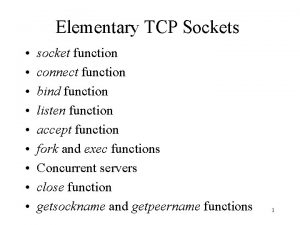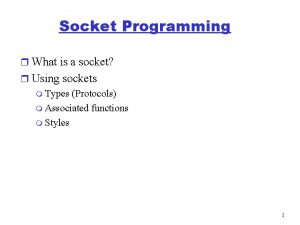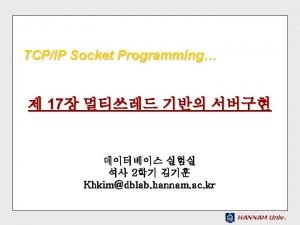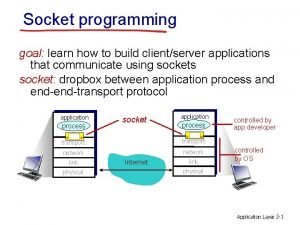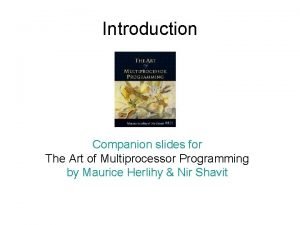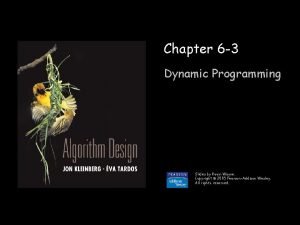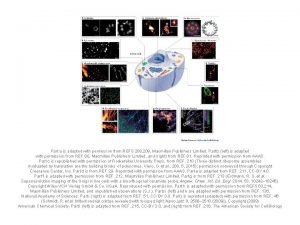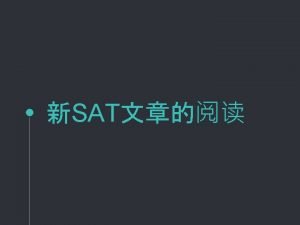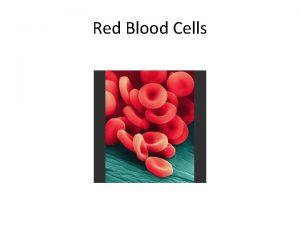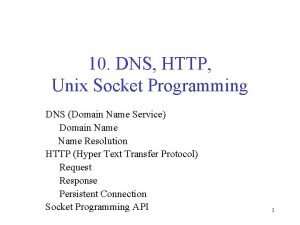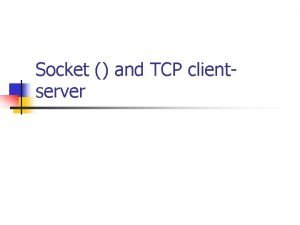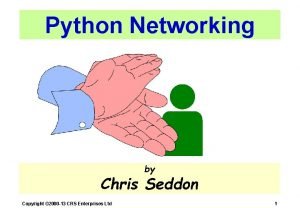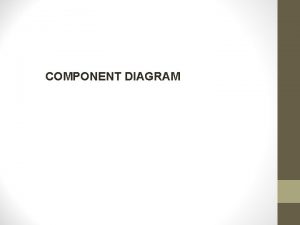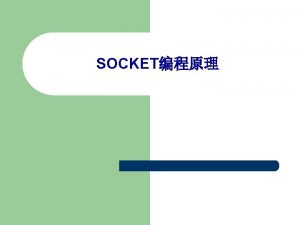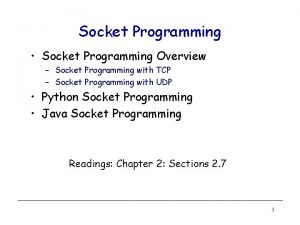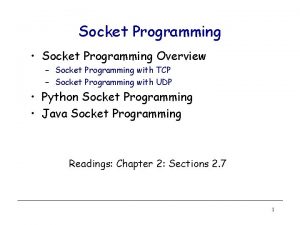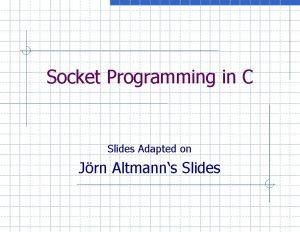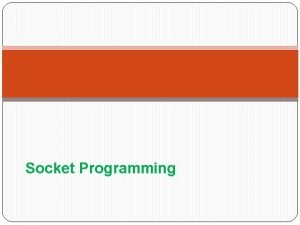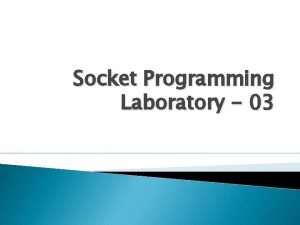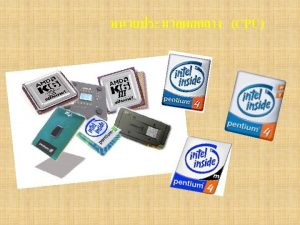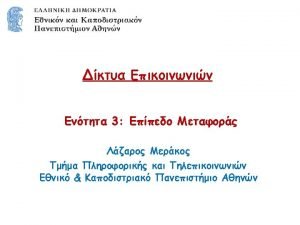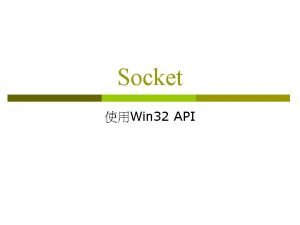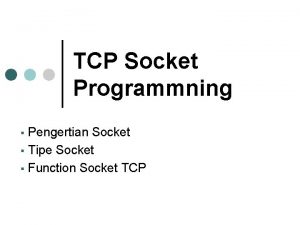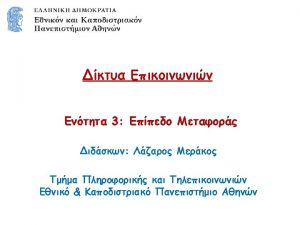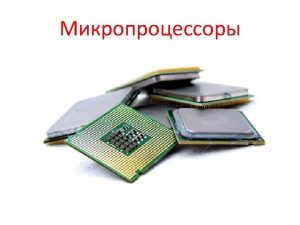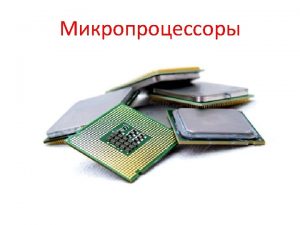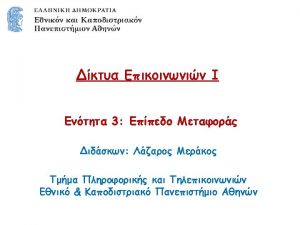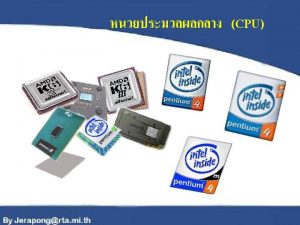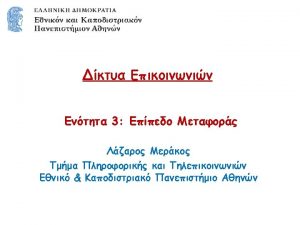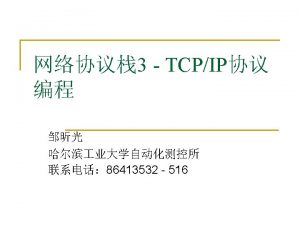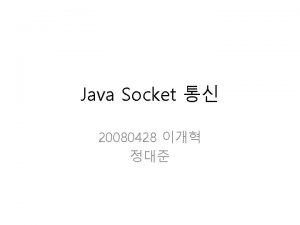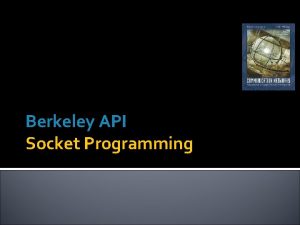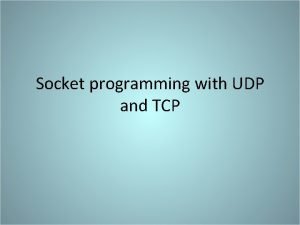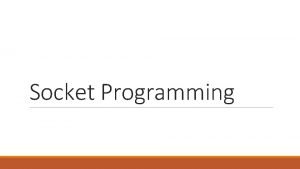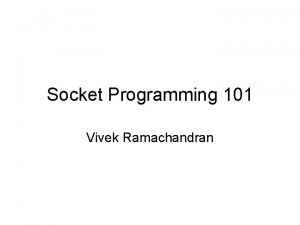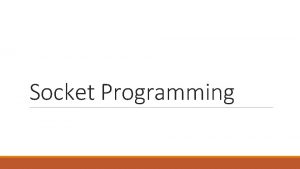Socket Programming in C Slides Adapted on Jrn

























![bind(): Assign IP and Port struct sockaddr_in sin; struct hostent *host = gethostbyname (argv[1]); bind(): Assign IP and Port struct sockaddr_in sin; struct hostent *host = gethostbyname (argv[1]);](https://slidetodoc.com/presentation_image/32acd757304c7485b9b23e9b6a1aada4/image-26.jpg)













- Slides: 39

Socket Programming in C Slides Adapted on Jörn Altmann‘s Slides CEN 4500 C

Questions that will be Addressed What mechanisms are available for a programmer who writes network applications? How to write a network application that sends packets between hosts (client and server) across an IP network? Answer: socket API Client CEN 4500 C IP Network Server 2

Socket Programming Table of Contents 1. Network Application Programming Interface: 2. 3. 4. 5. 6. CEN 4500 C Sockets and Internet Sockets Network Programming Tips Client-Server Architecture Example: Client Programming Example: Server Programming Network Programmer’s Mistakes 3

Layers of the IP Protocol Suite Application Layer Transport Layer Network Layer Link Layer CEN 4500 C e. g. ftp e. g. TCP, UDP e. g. IP Ethernet Application Layer Transport Layer Network Layer Link Layer 4

Protocol Suite Location Internet Protocol Layer Application Layer Transport Layer (TCP, UDP) Location Applications (e. g. browser, game, ftp) Application Programming Interface (API) (e. g. network API) Operating System (e. g. Unix) Network Layer (IP) Interface to the Network Card Link Layer CEN 4500 C Network Card & Device Driver (e. g. Ethernet card) 5

Network API Operating system provides Application Programming Interface (API) for network application API is defined by a set of function types, data structures, and constants Desirable characteristics of the network interface Simple to use n Flexible n w independent from any application w allows program to use all functionality of the network n Standardized w allows programmer to learn once, write anywhere Application Programming Interface for networks is called socket CEN 4500 C 6

Sockets provide mechanisms to communicate between computers across a network There are different kind of sockets DARPA Internet addresses (Internet Sockets) n Unix interprocess communication (Unix Sockets) n CCITT X. 25 addresses n and many others n Berkeley sockets is the most popular Internet Socket runs on Linux, Free. BSD, OS X, Windows n fed by the popularity of TCP/IP n CEN 4500 C 7

Internet Sockets Support stream and datagram packets (e. g. TCP, UDP, IP) Is Similar to UNIX file I/O API (provides a file descriptor) Based on C, single thread model n does not require multiple threads CEN 4500 C 8

Types of Internet Sockets Different types of sockets implement different communication types (stream vs. datagram) Type of socket: stream socket n n n connection-oriented two way communication reliable (error free), in order delivery can use the Transmission Control Protocol (TCP) e. g. telnet, ssh, http Type of socket: datagram socket n n n connectionless, does not maintain an open connection, each packet is independent can use the User Datagram Protocol (UDP) e. g. IP telephony Other types exist: similar to the one above 9 CEN 4500 C

Network Programming Tips Byte Ordering Naming Addressing CEN 4500 C 10

Byte Ordering of Integers Different CPU architectures have different byte ordering memory address A +1 memory address A Stored at little-endian computer high-order byte Integer representation (2 byte) D 3 F 2 low-order byte high-order byte Stored at big-endian computer CEN 4500 C low-order byte 11

Byte Ordering Problem Question: What would happen if two computers with different integer byte ordering communicate? n Answer: w. Nothing if they do not exchange integers! w. But: If they exchange integers, they would get the wrong order of bytes, therefore, the wrong value! Example: Message in Memory of little-endian Computer Processing Message is: [Hello, 1] 48 45 4 C 4 C 6 F 01 00 CEN 4500 C Message is: [Hello, 512] Message is sent across Network Message in Memory of of big-endian Computer Processing n 48 45 4 C 4 C 6 F 01 00 12

Byte Ordering Solution There are two solutions if computers with different byte ordering system want to communicate They must know the kind of architecture of the sending computer (bad solution, it has not been implemented) n Introduction of a network byte order. The functions are: n uint 16_t uint 32_t htons(uint 16_t htonl(uint 32_t ntohs(uint 16_t ntohs(uint 32_t host 16 bitvalue) host 32 bitvalue) net 16 bitvalue) net 32 bitvalue) Note: use for all integers (short and long), which are sent across the network n Including port numbers and IP addresses CEN 4500 C 13

Network Programming Tips Byte Ordering Naming Addressing CEN 4500 C 14

Naming and Addressing Host name identifies a single host (see Domain Name System slides) n variable length string (e. g. www. berkeley. edu) n is mapped to one or more IP addresses n IP Address written as dotted octets (e. g. 10. 0. 0. 1) n 32 bits. Not a number! But often needs to be converted to a 32 -bit to use. n Port number identifies a process on a host n 16 bit number n CEN 4500 C 15

Client-Server Architecture response Client Server request Client requests service from server Server responds with sending service or error message to client CEN 4500 C 16

Simple Client-Server Example response Client Server request socket() connect() send() recv() close() CEN 4500 C Connection establishment socket() bind() listen() accept() Data request recv() Data response send() End-of-file notification recv() close() 17

Example: Client Programming Create stream socket (socket() ) Connect to server (connect() ) While still connected: n n send message to server (send() ) receive (recv() ) data from server and process it Close TCP connection and Socket (close()) CEN 4500 C 18

socket(): Initializing Socket Getting the file descriptor int chat_sock; if ((chat_sock = socket(AF_INET, SOCK_STREAM, 0)) < 0) { perror("socket"); printf("Failed to create socketn"); abort (); } 1. parameter specifies protocol/address family 2. parameter specifies the socket type Other possibilities: SOCK_DGRAM 3. parameter specifies the protocol. 0 means protocol is chosen by the OS. CEN 4500 C 19

IP Address Data Structure struct sockaddr_in { short int sin_family; // Address family unsigned short int sin_port; // Port number struct in_addr sin_addr; // Internet address unsigned char sin_zero[8]; }; struct in_addr { unsigned long s_addr; }; // 4 bytes Padding of sin_zeros: struct sockaddr_in has same size as struct sockaddr CEN 4500 C 20

connect(): Making TCP Connection to Server struct sockaddr_in sin; struct hostent *host = gethostbyname (argv[1]); unsigned int server_address = *(unsigned long *) host->h_addr_list[0]; unsigned short server_port = atoi (argv[2]); memset (&sin, 0, sizeof (sin)); sin_family = AF_INET; sin_addr. s_addr = server_address; sin_port = htons (server_port); if (connect(chat_sock, (struct sockaddr *) &sin, sizeof (sin)) < 0) { perror("connect"); printf("Cannot connect to servern"); abort(); } CEN 4500 C 21

send(): Sending Packets int send_packets(char *buffer, int buffer_len) { sent_bytes = send(chat_sock, buffer_len, 0); if (send_bytes < 0) { perror (“send"); } return 0; } Needs socket descriptor, Buffer containing the message, and Length of the message Can also use write() CEN 4500 C 22

Receiving Packets: Separating Data in a Stream Fixed length record A 0 receive buffer B 1 2 C 3 4 5 D 6 7 8 9 slide through Use records (data structures) to partition the data stream CEN 4500 C 23

Receiving Packets int receive_packets(char *buffer, int buffer_len, int *bytes_read) { int left = buffer_len - *bytes_read; received = recv(chat_sock, buffer + *bytes_read, left, 0); if (received < 0) { buffer_len buffer perror (“recv"); } if (received <= 0) { return close_connection(); } *bytes_read += received; while (*bytes_read > RECORD_LEN) { process_packet(buffer, RECORD_LEN); *bytes_read -= RECORD_LEN; memmove(buffer, buffer + RECORD_LEN, *bytes_read); } return 0; } Can also use read() CEN 4500 C 24

Server Programming: Simple Create stream socket (socket() ) Bind port to socket (bind() ) Listen for new client (listen() ) While n n n CEN 4500 C accept user connection and create a new socket (accept() ) data arrives from client (recv() ) data has to be send to client (send() ) 25
![bind Assign IP and Port struct sockaddrin sin struct hostent host gethostbyname argv1 bind(): Assign IP and Port struct sockaddr_in sin; struct hostent *host = gethostbyname (argv[1]);](https://slidetodoc.com/presentation_image/32acd757304c7485b9b23e9b6a1aada4/image-26.jpg)
bind(): Assign IP and Port struct sockaddr_in sin; struct hostent *host = gethostbyname (argv[1]); unsigned int server_address = *(unsigned long *) host->h_addr_list[0]; unsigned short server_port = atoi (argv[2]); memset (&sin, 0, sizeof (sin)); sin_family = AF_INET; sin_addr. s_addr = server_address; sin_port = htons (server_port); if (bind(chat_sock, (struct sockaddr *) &sin, sizeof (sin)) < 0) { perror("bind"); printf("Cannot bind server application to networkn"); abort(); } CEN 4500 C 26

bind(): bind() tells the OS to assign a local IP address and local port number to the socket. Many applications let the OS choose an IP address. Use wildcard INADDR_ANY as local address in this case. At server, user process must call bind() to assign a port At client, bind() is not required since OS may assign available port and IP address n The server will get the port number of the client through the UDP/TCP packet header Note: Each application is represented by a server port number CEN 4500 C 27

listen(): Wait for Connections int listen(int sockfd, int backlog); Puts socket in a listening state, willing to handle incoming TCP connection request. Backlog: number of TCP connections that can be queued at the socket. CEN 4500 C 28

Server Example #define MYPORT 3490 // the port users will be connecting to #define BACKLOG 10 // how many pending connections queue will hold int main(void) { int sockfd, new_fd; // listen on sockfd, new connection on new_fd struct sockaddr_in my_addr; // my address information struct sockaddr_in their_addr; // connector's address information int sin_size; if ((sockfd = socket(AF_INET, SOCK_STREAM, 0)) == -1) { perror("socket"); exit(1); } my_addr. sin_family = AF_INET; // host byte order my_addr. sin_port = htons(MYPORT); // short, network byte order my_addr. sin_addr. s_addr = INADDR_ANY; // auto. filled with local IP memset(&(my_addr. sin_zero), '�', 8); // zero the rest of the struct CEN 4500 C 29

if (bind(sockfd, (struct sockaddr *)&my_addr, sizeof(struct sockaddr)) == -1) { perror("bind"); exit(1); } if (listen(sockfd, BACKLOG) == -1) { perror("listen"); exit(1); } while(1) { // main accept() loop sin_size = sizeof(struct sockaddr_in); if ((new_fd = accept(sockfd, (struct sockaddr *)&their_addr, &sin_size)) == -1) { perror("accept"); continue; } printf("server: got connection from %sn", inet_ntoa(their_addr. sin_addr)); if (send(new_fd, "Hello, world!n", 14, 0) == -1) perror("send"); close(new_fd); } return 0; } CEN 4500 C 30

Client Example #include <netinet/in. h> #include <sys/socket. h> #define PORT 3490 #define MAXDATASIZE 100 // the port client will be connecting to // max number of bytes we can get // at once int main(int argc, char *argv[]) { int sockfd, numbytes; char buf[MAXDATASIZE]; struct hostent *he; struct sockaddr_in their_addr; // server's address information if (argc != 2) { fprintf(stderr, "usage: client hostnamen"); exit(1); } if ((he=gethostbyname(argv[1])) == NULL) { // get the host info perror("gethostbyname"); exit(1); } if ((sockfd = socket(AF_INET, SOCK_STREAM, 0)) == -1) { perror("socket"); exit(1); CEN 4500 C} 31

their_addr. sin_family = AF_INET; // host byte order their_addr. sin_port = htons(PORT); // short, network byte order their_addr. sin_addr = *((struct in_addr *)he->h_addr); // already network byte order memset(&(their_addr. sin_zero), '�', 8); // zero the rest of the struct if (connect(sockfd, (struct sockaddr *)&their_addr, sizeof(struct sockaddr)) == -1){ perror("connect"); exit(1); } if ((numbytes=recv(sockfd, buf, MAXDATASIZE-1, 0)) == -1) { perror("recv"); exit(1); } buf[numbytes] = '�'; printf("Received: %s", buf); close(sockfd); return 0; } CEN 4500 C 32

I/O Blocking socket(); bind() ; listen(); while accept(); recv() ; send() ; Simple server has blocking problem n n CEN 4500 C Suppose 5 connections accepted. Suppose next accept() blocks. Other connections cannot send and receive. Cannot get keyboard input either. 33

select() : I/O Multiplexing waits on multiple file descriptors and timeout returns when any file descriptor is ready to be read or n written or n indicate an error, or n timeout exceeded n advantages simple n application does not consume CPU cycles while waiting n disadvantages n CEN 4500 C does not scale to large number of file descriptors 34

Example: Server Programming create stream socket (socket() ) Bind port to socket (bind() ) Listen for new client (listen() ) While Wait for (select() ) (depending on which file descriptors are ready) n accept user connection and create a new socket (accept() ) n data arrives from client (recv() ) n data has to be send to client (send() ) n CEN 4500 C 35

Server: Alternative Ways of Handling Many Clients Forking a new process for each client: fork() But, creating new process is expensive. Multithreaded implementation: have one thread handling each client. Thread is like a process but lightweighted. CEN 4500 C 36

Network Programmer’s Mistakes byte ordering separating records in streams use of select() misinterpreting the project specification not knowing all available system calls CEN 4500 C 37

There are more System Calls Depends on communication type n Datagram sockets use recvfrom() and sendto() for receiving and sending data Closing connection: close(), shutdown() Convenient functions (on UNIX) n n CEN 4500 C inet_aton, inet_ntoa inet_pton, inet_ntop 38

Literature short tutorial: Beej's Guide to Network Programming http: //www. ecst. csuchico. edu/~beej/guide/net/ Unix Network Programming, volumes 1 and 2 by W. Richard Stevens. Published by Prentice Hall; ISBNs for volumes 1 and 2: 013490012 X, 0130810819. Advanced Programming in the Unix Environment by W. Richard Stevens. Published by Addison Wesley. ISBN 0201563177. man pages on a Unix computer CEN 4500 C 39
 Bind function in socket programming
Bind function in socket programming R socket programming
R socket programming Socket programming in c
Socket programming in c Gqoute
Gqoute Android udp client example
Android udp client example Socket r
Socket r Socket programming
Socket programming Bsd socket programming
Bsd socket programming A small child slides down the four frictionless slides
A small child slides down the four frictionless slides A child is on a playground swing motionless
A child is on a playground swing motionless Art of multiprocessor programming slides
Art of multiprocessor programming slides Dynamic programming slides
Dynamic programming slides How is amoeba adapted for gas exchange bbc bitesize
How is amoeba adapted for gas exchange bbc bitesize In what ways have the highland maya adapted to modern life?
In what ways have the highland maya adapted to modern life? Adapted with permission from
Adapted with permission from Estimate synoynm
Estimate synoynm Adapted animals in the rainforest
Adapted animals in the rainforest How have plants adapted to the rainforest
How have plants adapted to the rainforest Xerophytic adaptation in plants
Xerophytic adaptation in plants Behavioral adaptations of zebras
Behavioral adaptations of zebras The two brothers adapted
The two brothers adapted This passage is adapted from jane austen
This passage is adapted from jane austen Spermopsida
Spermopsida Birds in the chaparral biome have adapted to living
Birds in the chaparral biome have adapted to living Adapted from the internet
Adapted from the internet Erythroposis
Erythroposis The outsiders adapted for struggling readers
The outsiders adapted for struggling readers 5 adaptive features of camel
5 adaptive features of camel Greedy algorithm vs dynamic programming
Greedy algorithm vs dynamic programming Definisi integer
Definisi integer System programming
System programming Perbedaan linear programming dan integer programming
Perbedaan linear programming dan integer programming Integer programming vs linear programming
Integer programming vs linear programming The system which gives a definite shape to our body is
The system which gives a definite shape to our body is Http unix socket
Http unix socket Socket outline
Socket outline Socket server
Socket server Komponen diagram
Komponen diagram Applicazione distribuita
Applicazione distribuita Radial circuits
Radial circuits
